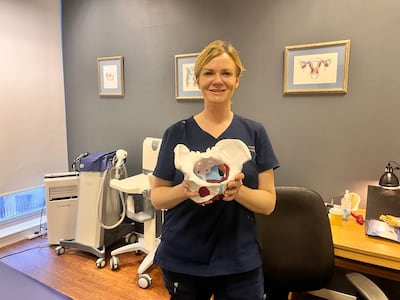It can be embarrassing to admit that you sometimes leak urine when you run. As a topic that is rarely spoken about in running circles, you might feel that you are the only one to struggle. But you are not alone.

When I asked the question of the women in my running community, who range in age from late 20s to early 70s, urinary incontinence on the run was a much bigger issue than I had ever imagined.
More common than you think
Are you one of the many female runners who only run at certain times of the day or avoid drinking water in an attempt to manage your bladder’s unpredictability? It may have become so uncomfortable or inconvenient that you have given up running completely fearing that the running itself might even be the cause of the problem. Whatever your symptoms and however long it has been going on, it is time to learn more about the latest research and see what new options are available to you.
Different for everyone
Enthusiastic Women’s Health physiotherapist Aoife Harvey is passionate about helping women with all sorts of pelvic floor problems. Due to the number of questions I was getting within my running community, I needed expert advice and Harvey joined me on a podcast for our runners answering all their questions around leaking.
‘There are times I regret having kids. They’re adults, and it’s now that I’m regretting it, which seems strange’
Cillian Murphy: ‘You had the Kerry babies, the moving statues, no abortion, no divorce. It was like the dark ages’
The Dublin couple who built their house in a week
John Creedon: ‘I was always being sent away, not because they didn’t love me, but because they couldn’t cope’

I breathed a sigh of relief when I asked her the most popular question: Is running the problem and could it cause more damage? Thankfully, she confirmed that running wasn’t the issue that causes the leaking. It can be the time when women experience most symptoms, but that is due to the repetitive impact of the movement and the downward pressure on the body. In fact, Harvey praises all the health benefits of running but encourages women to take responsibility around the leaking and find ways to prevent and manage it.
Two types of leaking
Symptoms of leaking vary widely. While some women can leak or dribble gradually without even noticing when on the run others get sudden urges to rush to the toilet. Some people can experience both types and the volume of leaking can vary widely too. All types of leaks come as a result of the bladder coming under pressure.
The tissues in the pelvic area cannot support the internal pelvic organs fully. Injury, pregnancy and childbirth, age, hormones, prolapse and even genetics can all be at the root of the problem.
A fount of knowledge
For many years I assumed that kegels (which involve tightening and then releasing the muscles in your pelvic floor to strengthen them) or other pelvic floor exercises were the only solution to leaking. As soon as I mention the word kegels, women countrywide are clenching their pelvic floor muscles trying to remember the last time they did these exercises.
We were led to believe that any issues linked to our pelvic floor were caused by not doing enough of these mini-workouts. But, for many of us, myself included, these muscles were already tight enough and just needed to relax. Kegels was never going to be the full solution. Harvey explains that the pelvic floor muscles are only part of the equation. The condition of the valves of the urethra and the connective tissue which supports the pelvic area also play a huge role in incontinence issues. The role of the women’s health physiotherapist is to identify where in the pelvic area the problem has originated and offer steps to manage it.
Start with comfort
Incontinence pads are a product that has boomed in recent years as you may have noticed from all the television adverts. Pads can be a first line of support for runners who want to be confident they won’t leak through their clothes and can relax when running. These absorb urine and avoid underwear feeling wet on the skin. Harvey stresses these are not the same as period sanitary pads which should never be used for urine.
Instead of using regular sanitary towels, look into the various sizes of incontinence pads on the market. They can be expensive but are more compact and absorbent than you might think. With a growing demand for such pads, there are more brands and cheaper options out there all the time.
Pessaries and gadgets
While pads may offer some comfort, they don’t prevent the leaking. Harvey recommends looking at pessaries (products that are inserted into the vagina) that can help support the bladder. Some runners find that inserting a tampon can give the scaffolding needed to avoid leaking but there are many more options out there that range in all shapes and sizes that aim to reduce the pressure on the bladder.
In all my years of running, I had never seen most of the products that Harvey showed me and I was surprised, and delighted, when she told me how many of her patients use them with great success for running and other daily activities.

Notice your patterns
It helps to track your symptoms so you can see what situations trigger leaking. Most people will find that morning running is easier on the body as muscles and tissues are fresher than in the evening. Running on an empty stomach too can help. Running shortly after a good bowel movement can also make the pelvic area feel lighter and take pressure off the bladder. Certain times of your menstrual cycle can also have an impact on the level of leaking.
Even the weather can bother us. Harvey describes how we are more inclined to leak in cold weather and she also reminds me that the running terrain can make a difference too. Symptoms will be worse when running downhill and also mentions that heavier runners will also have more symptoms due to the extra weight bearing down on the pelvis.
Will it get worse as I get older?
Aging is indeed a significant factor and with the drop in estrogen, there is less blood flow all over the body, not just the pelvic area. As we age muscle fibres naturally weaken all over and Harvey encourages all women to build general strength training into our running routines. She also believes that every woman post-menopause should be taking vaginal estrogen. This is not hormone replacement therapy (HRT), but a very small dose of estrogen that is inserted into the vagina regularly.
From helping urinary tract infections and bladder urgency especially, she promotes it to all of her patients post-menopause. Even for younger women this very small dose of vaginal oestrogen can help and can be taken in conjunction with HRT too.
When should I get surgery?
When exercises, pessaries and other forms of physiotherapy and lifestyle changes do not work, some people will then consider having surgery. Harvey explains that some procedures can be done that are minimally invasive which bulk up the urethra valves, but is cautious about saying that surgery will cure all symptoms.
She is optimistic about a new type of mesh surgery that will be coming to Ireland shortly but stresses that you need to know the source of the problem before heading down the road to surgery so you are sure you are fixing the right piece of the jigsaw.
Do something about it
Until you know the cause of your incontinence you cannot be sure you are treating it correctly. Don’t ignore it or accept it as a normal part of life. Visit a recommended women’s health physiotherapist in your area and work together to identify what helps you move forward.
As women, we can continue to joke about avoiding trampolines and crossing our legs when sneezing, or we can take the time to invest in our future health, learn more about our body and equip ourselves with that knowledge that will help us hop, skip and jump long into the future.
Sign up to Get Running

- Beginner plan: Eight-week course that will build you up to running 30 minutes non-stop.
- Stay on Track plan: Eight-week course for those who can squeeze in a 30-minute run a few times a week.
- Advanced plan: Eight-week course for those who want to move up to the 10km mark.
- Mary Jennings is founder of ForgetTheGym.ie




